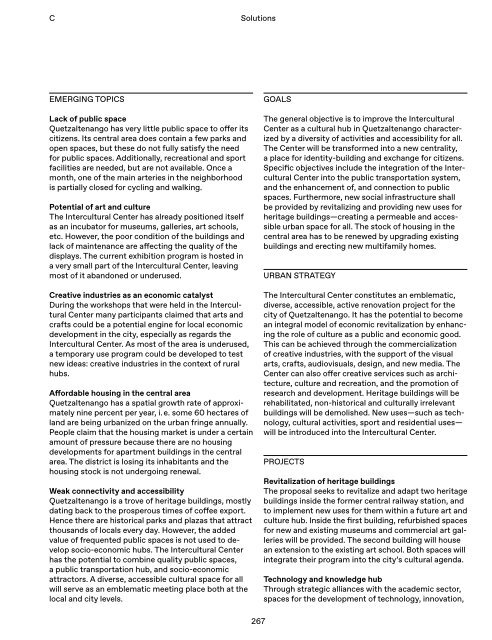Urban Design Lab Handbook – Dialogue-oriented urban transformation processes and practical approaches from Latin America and the Caribbean
ISBN 978-3-86859-562-8 https://www.jovis.de/en/books/preview/product/urban-design-lab-handbook.html
ISBN 978-3-86859-562-8
https://www.jovis.de/en/books/preview/product/urban-design-lab-handbook.html
You also want an ePaper? Increase the reach of your titles
YUMPU automatically turns print PDFs into web optimized ePapers that Google loves.
C<br />
Solutions<br />
EMERGING TOPICS<br />
GOALS<br />
Lack of public space<br />
Quetzaltenango has very little public space to offer its<br />
citizens. Its central area does contain a few parks <strong>and</strong><br />
open spaces, but <strong>the</strong>se do not fully satisfy <strong>the</strong> need<br />
for public spaces. Additionally, recreational <strong>and</strong> sport<br />
facilities are needed, but are not available. Once a<br />
month, one of <strong>the</strong> main arteries in <strong>the</strong> neighborhood<br />
is partially closed for cycling <strong>and</strong> walking.<br />
Potential of art <strong>and</strong> culture<br />
The Intercultural Center has already positioned itself<br />
as an incubator for museums, galleries, art schools,<br />
etc. However, <strong>the</strong> poor condition of <strong>the</strong> buildings <strong>and</strong><br />
lack of maintenance are affecting <strong>the</strong> quality of <strong>the</strong><br />
displays. The current exhibition program is hosted in<br />
a very small part of <strong>the</strong> Intercultural Center, leaving<br />
most of it ab<strong>and</strong>oned or underused.<br />
Creative industries as an economic catalyst<br />
During <strong>the</strong> workshops that were held in <strong>the</strong> Intercultural<br />
Center many participants claimed that arts <strong>and</strong><br />
crafts could be a potential engine for local economic<br />
development in <strong>the</strong> city, especially as regards <strong>the</strong><br />
Intercultural Center. As most of <strong>the</strong> area is underused,<br />
a temporary use program could be developed to test<br />
new ideas: creative industries in <strong>the</strong> context of rural<br />
hubs.<br />
Affordable housing in <strong>the</strong> central area<br />
Quetzaltenango has a spatial growth rate of approximately<br />
nine percent per year, i. e. some 60 hectares of<br />
l<strong>and</strong> are being <strong>urban</strong>ized on <strong>the</strong> <strong>urban</strong> fringe annually.<br />
People claim that <strong>the</strong> housing market is under a certain<br />
amount of pressure because <strong>the</strong>re are no housing<br />
developments for apartment buildings in <strong>the</strong> central<br />
area. The district is losing its inhabitants <strong>and</strong> <strong>the</strong><br />
housing stock is not undergoing renewal.<br />
Weak connectivity <strong>and</strong> accessibility<br />
Quetzaltenango is a trove of heritage buildings, mostly<br />
dating back to <strong>the</strong> prosperous times of coffee export.<br />
Hence <strong>the</strong>re are historical parks <strong>and</strong> plazas that attract<br />
thous<strong>and</strong>s of locals every day. However, <strong>the</strong> added<br />
value of frequented public spaces is not used to de -<br />
velop socio-economic hubs. The Intercultural Center<br />
has <strong>the</strong> potential to combine quality public spaces,<br />
a public transportation hub, <strong>and</strong> socio-economic<br />
attractors. A diverse, accessible cultural space for all<br />
will serve as an emblematic meeting place both at <strong>the</strong><br />
local <strong>and</strong> city levels.<br />
The general objective is to improve <strong>the</strong> Intercultural<br />
Center as a cultural hub in Quetzaltenango characterized<br />
by a diversity of activities <strong>and</strong> accessibility for all.<br />
The Center will be transformed into a new centrality,<br />
a place for identity-building <strong>and</strong> exchange for citizens.<br />
Specific objectives include <strong>the</strong> integration of <strong>the</strong> Intercultural<br />
Center into <strong>the</strong> public transportation system,<br />
<strong>and</strong> <strong>the</strong> enhancement of, <strong>and</strong> connection to public<br />
spaces. Fur<strong>the</strong>rmore, new social infrastructure shall<br />
be provided by revitalizing <strong>and</strong> providing new uses for<br />
heritage buildings—creating a permeable <strong>and</strong> accessible<br />
<strong>urban</strong> space for all. The stock of housing in <strong>the</strong><br />
central area has to be renewed by upgrading existing<br />
buildings <strong>and</strong> erecting new multifamily homes.<br />
URBAN STRATEGY<br />
The Intercultural Center constitutes an emblematic,<br />
diverse, accessible, active renovation project for <strong>the</strong><br />
city of Quetzaltenango. It has <strong>the</strong> potential to become<br />
an integral model of economic revitalization by enhancing<br />
<strong>the</strong> role of culture as a public <strong>and</strong> economic good.<br />
This can be achieved through <strong>the</strong> commercialization<br />
of creative industries, with <strong>the</strong> support of <strong>the</strong> visual<br />
arts, crafts, audiovisuals, design, <strong>and</strong> new media. The<br />
Center can also offer creative services such as architecture,<br />
culture <strong>and</strong> recreation, <strong>and</strong> <strong>the</strong> promotion of<br />
research <strong>and</strong> development. Heritage buildings will be<br />
rehabilitated, non-historical <strong>and</strong> culturally irrelevant<br />
buildings will be demolished. New uses—such as technology,<br />
cultural activities, sport <strong>and</strong> residential uses—<br />
will be introduced into <strong>the</strong> Intercultural Center.<br />
PROJECTS<br />
Revitalization of heritage buildings<br />
The proposal seeks to revitalize <strong>and</strong> adapt two heritage<br />
buildings inside <strong>the</strong> former central railway station, <strong>and</strong><br />
to implement new uses for <strong>the</strong>m within a future art <strong>and</strong><br />
culture hub. Inside <strong>the</strong> first building, refurbished spaces<br />
for new <strong>and</strong> existing museums <strong>and</strong> commercial art galleries<br />
will be provided. The second building will house<br />
an extension to <strong>the</strong> existing art school. Both spaces will<br />
integrate <strong>the</strong>ir program into <strong>the</strong> city’s cultural agenda.<br />
Technology <strong>and</strong> knowledge hub<br />
Through strategic alliances with <strong>the</strong> academic sector,<br />
spaces for <strong>the</strong> development of technology, innovation,<br />
267


















